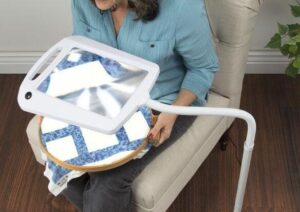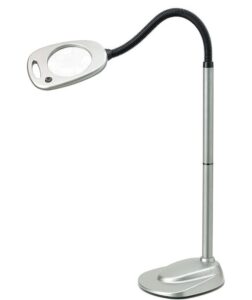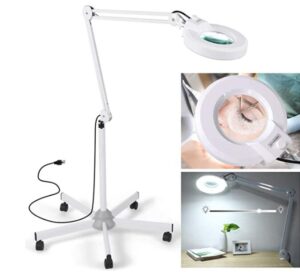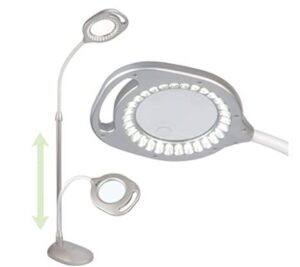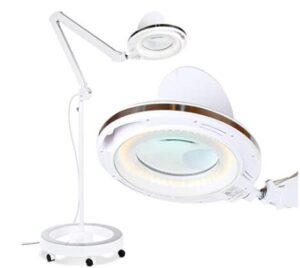If you are engaged with sewing and needlework and struggling with your sight, you probably need a magnifying floor lamp.
Even if you don’t have problems with your eyesight, you need a magnifying floor lamp as long as you do needlework or work with precision tools.
Still, suppose you are working with miniature items like needles for sewing, doing craftwork, or having aging eyes. In that case, you will likely need some visual aid that will guarantee you an excellent job.
Apart from all these, it would help if you also had appropriate lighting to work during low light or dark times.
However, for those with macular degeneration, a magnifying floor lamp is compulsory for you. It would help if you had it for reading, writing, sewing, or detailed work. That is where magnifying floor lamp comes in.
This article will show you how to choose the best magnifying floor lamp for your needlework.
How to Choose the Best Magnifying Floor Lamp for Needlework?
1. What Color Temperature to Choose?
When choosing a magnifying floor lamp for needlework, one vital thing is the color temperature.
Magnifying floor lamps come in different lighting modes that can be easily adjusted. The brightness level can be adjusted to between 10% and 100% to create a lighting effect to your preference.
The best color temperature of magnifying floor lamps to use for needlework depends on individual needs. They come in different temperature levels.
As researched, daylight which ranges from 4500K to 6500K is the best choice.
Magnifying floor lamps have the cool white bright light of 6500K to illuminate your work area and eliminate dark shadows.
The 4500K warm white light provides a natural daylight effect for work at any time of the day.
Generally, if you suffer from low vision or aged eyes, magnifying floor lamp with 6500K is the best for needlework because it can provide ‘natural’ light and the clearest light to your room.
>> Check UMPOOL 6500K magnifying floor lamp for sewing
2. How to Choose Size and Height?
In buying a magnifying floor lamp for needlework, height is essential to consider. There are various sizes and heights available.
However, it would help if you had a height suitable to your purpose.
The average height of magnifying floor lamp is between 40″ and 70″.
You can freely get one that matches your height. The best size and height of a magnifying floor lamp to light up your needlework at hand is the one that can provide focus on your work area.
Not sure what size you should consider? Don’t worry!
There are magnifying floor lamps with adjustable height features. The adjustable height allows you to work on the sewing area without stress.
Most magnifying floor lamps for needlework come with a gooseneck that will enable you to adjust the neck to your preferred position.
>> Check Brightech magnifying floor lamp with adjustable gooseneck
3. What Magnification Lens Power Is Great for Sewing and Embroidery?
Vision magnification is the primary purpose of a magnifying floor lamp. It makes small items visible to the ailing eyes or provides a visual aid for close work such as needlework.
Magnification lens power determines how much a given lens can make an image appear.
The commonly seen diopter for sewing magnifying floor lamps is 3d, 5d, 8d, equivalent to 1.75x, 2.25x, and 3x.
A diopter is a unit of measurement of the optical power of a lens.
For a 1.75x magnifying floor lamp, the image is made 170% larger in appearance. It provides almost a natural daylight brightness, makes your eyes remain fresh all day, no red-eyes, no headaches, no worries! It is best for needlework. (Buy a 1.75x magnifying floor lamp for needlework)
The 2x magnification is the best-recommended floor lamp for needlework because it provides you with a light boost that is enough to illuminate your needlework space. It is perfect for those with low vision. (Buy a 2x lamp)
3x magnifying floor lamp brings the object closer by 33.3ft distance. It means that the thing appears bigger while reducing the viewing spaces.
The 3x magnifying lamp is perfect for detailed work such as needlework and embroidery work. It will let you perfectly see the knitting, stitches, and tiny colors. (Buy a 3x floor lamp)
4. What Kind of Embedded LED Bulbs Are Worth It?
Since you don’t need to be replacing your LED light, you need a durable and long-lasting LED for your needlework.
To be considered durable, an LED magnifying floor lamp for needlework should be a minimum of 20,000 hours of work – the equivalent of 20 years. Some magnifying lamp LEDs can last up to 40,000 hours.
5. Why Do You Require a Flexible Arm?
It is essential that you buy a magnifying floor lamp with a heavy, sturdy base with a flexible and strong arm.
The flexible arm allows you to adjust the light, magnify the lens or brighten your space, while the strong base provides stability so that your lamp does not tilt over.
You’re sure to have a beautiful lighting experience while doing your needlework.
The magnifying floor lamp with a flexible gooseneck arm for needlework allows you to fine-tune the angle of the lamp to focus on your desired area.
You can easily adjust it to concentrate the array of light to the direction and space of your work.
>> Check LIGHT IT BY FULCRUM magnifying floor lamp with gooseneck for more flexible angle adjustment
What of the magnifying floor lamp with a swing arm? This is an excellent gift to needlework.
The swingarm is a multi-angle adjustment piece that allows you to swing it up/down rotate left/right to give you a large viewing area.
>> Check the LANCOSC swing arm magnifying floor lamp with a rolling base
6. What Kind of Light Should Be Equipped for Cross Stitch?
Lumens means the total amount of visible light emitted by a bulb. The more the lumens, the brighter the bulb. The brightness of your magnifying floor lamp depends on the number of lumens you have.
It would help if you had an LED floor lamp of at least 450 lumens for your needlework for quality brightness.
Choose the Right Lumens to Clear Vision When Do Needlework
Choosing the appropriate magnifying floor lamp lumens for average adults’ needlework is essential. Ideally, a light of 450 lumens is suitable for the average adult doing needlework. The fewer the lumens, the dimmer the brightness.
What works for the average adult may not work for seniors with aging eyes.
A magnifying floor lamp with at least 800 lumens is perfect for seniors’ needlework.
It provides a far-reaching beam of light for the workspace and can direct the illumination to focus on miniature objects.
It also creates a broader flashlight to enhance your lighting experience. It provides you with a clear vision when doing your needlework.
Choose the Right Brands Based on Your Usage
1. Ottlite – Provide Clarity in Cross Stitch
The Ottlite is often described as the lamp by which other lamps can be judged. It is a brand that is highly honored amongst its contemporaries. When you talk of a magnifying floor lamp for needlework, the Ottlite readily comes to mind.
From multiple settings, unique brightness, and magnificent color temperature, the Ottlite ensures that you get the appropriate lighting you need.
Some of the Ottlite products have built-in handles and adjustable necks, allowing you to use the light wherever you want. Some are hands-free, giving you the option of having both hands on your work.
The Ottlite’s super-bright LEDs light emits natural daylight. Their unique daylight illumination is very convenient for the eyes and has brought natural daylight indoors!
Amongst the magnifying floor lamps for needlework, the Ottlite is most suitable because they display colors accurately and show minute details with fantastic clarity even at night.
2. Brightech – Provides Bright Light and High Quality Lens
The Brightech magnifying floor lamp is another beautiful brand suitable for needlework.
Coming in varying sizes and forms – from standing, tall, shelf, modern LED lamps, they’re made of high-quality lenses for your comfort and convenience.
Users of Brightech have indicated that they can provide the eyes with extra light and magnify the objects to see minute details.
They’re ideal for sewing and needlework because they make individual threads and tiny colors more visible in a sewing project.
A delight to crafters, the Brightech’s magnification can provide enough illumination to see stitches and all the details of your embroidery.
Magnifying Floor Lamp vs. Magnifying Glass with Light: How to Choose for Needlework?
– Magnifying Glasses
A magnifying glass helps you to see small objects in better detail. The magnifying glass with light helps to illuminate the object so that you can read, sew, or work in dark places or where there is low light.
A typical magnifying glass with light has a built-in LED light around the handle, or in some cases, around the lens perimeter. They are usually battery-powered.
Some magnifying glasses with light are handheld, while you can wear some on the head with illuminated LED light woven around the lens.
A magnifying glass with light is helpful to those with far-sightedness and people with macular degeneration.
They can provide 30x magnification and help those with low vision read small letters, the elderly with aging sight, and those engaged with electronic repairs. They are easy and convenient to use.
What differentiates the magnifying glass from others is that the magnifying glass is lightweight and portable and can easily be carried about during quick trips.
You can easily slip it into your bag. If you are traveling and have to carry your magnifier, the lighted magnifying glass is very convenient.
The magnifying glass with light is best for your needlework for those who are always on the move.
The following are hot sale magnifying glasses on the market,
– Magnifying Floor Lamp
The magnifying floor lamp is best suitable for needlework when you are in a sitting position or you are working on a table.
It provides more space to work, gives you more comfort, and works in a relaxed mood. It also brings you closer to your work to have precision and perfect concentration and focus on your work.
A magnifying floor lamp is best for embroidery, sewing, knitting and anything that requires precision.
Generally speaking, both the magnifying floor lamps and the lighted magnifying glasses are lovely tools for needlework.
The magnifying floor lamps have features like hands-free, adjustable size and heights, goosenecks, powerful magnifications, and lots more. Furthermore, it adds to the sophistication and beauty of your space.
- If you go for portability and light weight, the lighted magnifying glass is what you want.
- But if you pursue more bright light in the sewing room, magnifying floor lamp will be the best choice.
Correctly Use the Magnifying Floor Lamp to Ensure Safe Needlework
It is better to use natural, bright daylight for your needlework, but you can seek artificial light and magnification where this is not feasible.
Magnifying floor lamps provide magnification to objects like threads and stitches that are not visible to the ordinary eyes. It’s to give a visual aid to weak eyesight.
However, if not correctly used, it can cause damage to your eyes.
Here are some tips about the safe use of magnifying floor lamps when sewing:
- Don’t focus on sunlight with a magnifying light because it can cause eye impairment.
- Don’t concentrate a magnifying glass on sunlight because it can cause a fire.
- Don’t stay too long gazing on a magnifying lamp, which can damage the eyes.
- Be mindful of the magnifying lamp to buy because the cheap lens can harm your eyes. If possible, use prescribed glasses.
To use a magnifying floor lamp, hold the lens up close to your eyes, bring the object close to the lens, just a few centimeters away from your face, and look into the glass.
You can adjust the distance between the object and the magnifier until you get the proper view or the exact size of the image. The ideal distance should be between 8″ and 10″ away from the glass.

